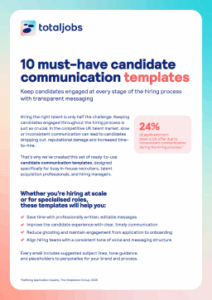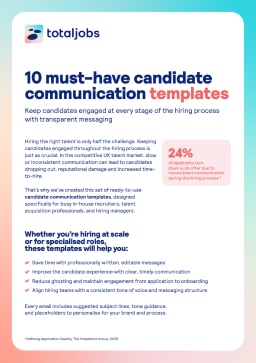
How to write an effective job description: Best practices and insights
Table of Contents
- What is a job description?
- Writing a job description
- Things to avoid in a job description
- FAQs

Candidate Communication Templates
With over 12,000 companies advertising on Totaljobs at any given time, a clear, informative, and compelling job description is key to effectively securing the best hire for a role.
From summarising key tasks to selling yourself as an employer, this guide will help you write a job description that not only stops the best candidates in their tracks but also clearly outlines why a role is right for them.
What is a job description?
A job description is created by an employer to outline the tasks, list of responsibilities, and expectations for a specific role. Written to inform and engage candidates while providing clarity to the wider organisation, it covers the required skills, qualifications, and experience for the successful candidate.
The difference between a job description and job advert
The function of a job description and a job advert overlap, and this can lead to confusion in the different roles they play in the hiring process.
A job advert promotes a vacancy, attracting potential candidates by highlighting key aspects of the open role and selling points of an employer. It’s a job posting that is typically short, and to the point, with the aim of capturing the immediate attention of candidates.
A job description goes into much greater detail on the duties, responsibilities, and expectations of a role. While some elements, such as the key responsibilities, are relevant for a job advert, a job description is also targeted towards internal stakeholders, serving as a reference for HR purposes, performance evaluations, colleagues and employees.
The purpose of a job description
A carefully written job description is instrumental in making the best possible match between a new hire’s capabilities, ambitions, and the requirements of the role, helping to increase the odds of making a long-term successful hire.
It does this through:
- Attracting candidates: A well-crafted job description guides the creation of a compelling job advert, which ignites interest in the vacancy and helps job seekers assess their fit for the role. Successfully doing so can ultimately save time in shortlisting, interviewing, and hiring the right person.
- Providing clear expectations: A job description provides a ‘north star’ for potential hires by helping them visualise the day-to-day responsibilities of the role, and what will be expected of them. It essentially serves as an agreement between an employer and employee by clearly outlining the tasks, duties, and requirements of the role.
- Giving a reference for management and their colleagues: Internally, job descriptions are vital for providing stakeholders with a clear understanding of a role’s purpose, which is highly valuable for aligning goals within the organisation and fostering effective collaboration. On top of this, a concise list of an employee’s responsibilities can support management, and particularly less experienced managers, in gauging their performance. Considering this, if you’re working alongside the hiring manager, it’s essential to ensure you’re completely aligned when writing the job description to avoid confusion.
- Supporting talent development: A clear job description can also contribute to talent development, by providing a framework to identify areas for improvement and progression within the organisation. Consider how you can use ‘cascading’ job descriptions, which differentiate between seniority levels within the team. With this, employees can understand the skills required for career progression.
Writing a job description
Follow these steps to start writing good job descriptions that make the purpose of a role crystal clear to potential candidates, colleagues, and stakeholders. Using this as a job description template structure will put you on the right track for all future job descriptions you publish.
Decide on a job title
When writing a job description, remember that an easily understood job title can be decisive. Avoid flashy terms like ‘Rockstar’ or ‘Ninja’, opting for plain language that not only fosters workplace collaboration but also boosts search visibility in the recruitment process.
Provide an overview of the organisation
Add an ‘About Us’ section to spotlight your mission, culture, work environment, values, and the services you offer.
When recruiting, a well-informed candidate is the ideal candidate. Ensure you work with the hiring manager to offer specific details on the team, including rewards, the tools and technology provided, and specific targets or achievements specific.
Include a summary paragraph
Include a short paragraph in the job description that gives a broad overview of the position’s responsibilities, highlighting its purpose within the organisation.
Treat it as your elevator pitch — imagine explaining it to a new colleague who asks, “What does this person do?” This will help any prospective applicant understand the role at a glance.
List the key responsibilities
Cut to the chase with digestible bullet points that list the key responsibilities of the position to help candidates understand what it entails.
It’s crucial to strike the balance between vague and overkill, so keep your aim in mind — to make it easy for anyone to be able to picture a typical day in the role.
State the necessary qualifications
Clearly outline the specific qualifications and experience required for the role, using bullet points for easy reading. Ensure your expectations are realistic by aligning skills with the role’s level. Additionally, consider including essential soft skills, such as the ability to present to larger audiences.
Confirm the salary and benefits
The best job descriptions include the salary or salary range for the role. We know that transparency around salary and benefits can encourage people to apply and significantly improve the quality of responses.
Consider benchmarking the salary you offer, and include this information in your job description and highlight enticing benefits, such as a hybrid working policy, gym membership discounts, and more, to attract top-tier candidates.
Highlight the company culture
Provide insight into your culture by highlighting your values, way of working and anything else that makes your company unique. Use tangible examples such as team events, rewards, and activities to illustrate your workplace.
Emphasise your commitment to Diversity, Equity, and Inclusion or employee wellbeing, offering real-life glimpses into the day-to-day experiences that set your culture apart.
Be clear about location
Let potential candidates know where they will be based — and for hybrid roles — how often they will be expected to be in the office. Include as specific information as possible, down to postcode level, so candidates can plan their commute before applying. This is also a good place to state if you have set working hours, or if there is flexibility around this.
Things to avoid in a job description
We’ve set out what to include in the job description, but there are some things that are best avoided.
Internal jargon and terminology
Clarity is the lifeblood of your recruitment efforts. Jargon, acronyms, and terminology can confuse external candidates, and derail their application for the role. If in doubt, think of the average person on the street — and tailor your job description to them.
For example:
- Replace – “Become an R&D guru, where proficiency in AI and ML technologies is a must for this role.”
- With – “Analyse data within our Research and Development team, where experience in artificial intelligence (AI) and machine learning (ML) technologies is essential for delivering real-time audience insights.”
Vagueness
Transparency doesn’t mean skimping on the details. Avoid vagueness and construct a job description that explicitly outlines what candidates can expect from the role and informs existing employees about their new colleague’s responsibilities. Use active verbs to emphasise what they will be doing and breathe life into the job description.
For example, if you’re recruiting for a Project Manager, avoid relying on vague descriptions like, “You will be responsible for managing large-scale projects.”

Provide specific duties such as:
- Coordinate project timelines and deliverables.
- Organise and chair fortnightly meetings with cross-functional teams for the sharing of project updates.
- Write and share a weekly summary email to the necessary stakeholders.
Being unrealistic
Avoid unrealistic expectations. Include only the minimum required level of skills and qualifications for a role to attract more applications. Look at similar job descriptions online to sense-check what you have, and make sure you don’t inadvertently dissuade the right candidates.
A common example of this is found in the desired years of experience, where, for example, a Junior Graphic Designer is unlikely to have spent ‘5+ years in a high-functioning art studio.’
Also, be sure not to overwhelm potential applicants. It’s best to talk to those currently in the team to get a feel for the average day’s workload, and ensure it aligns with what you include in a job description.
Discriminatory language
Use inclusive language within your job advert and be sure to avoid gendered pronouns and leading statements that could dissuade qualified candidates from applying, or even discriminate against them.
For example:
- Avoid phrases such as, “We are looking for a leader of men, who is able to rally the troops and hunt out new business.”
- Consider replacing with, “We are looking for an inspirational leader for our new business team, who is able to coach, guide and develop our sales team to achieve their targets.”
Frequently asked questions (FAQs)
What exactly is a job description?
It’s a document created by an employer outlining the tasks, duties, expectations, required skills, qualifications, and experience for a specific role, serving both candidate clarity and internal reference purposes.
How does a job description differ from a job advert?
A job advert promotes the vacancy and attracts applicants with a concise, engaging summary. In contrast, a job description provides detailed information on responsibilities and requirements, and often supports internal functions such as HR and performance evaluation.
What purpose does a well-written job description serve?
Why is transparency around salary and location important?
How can a job description support internal processes?
How do I ensure my job description attracts the right people?
Explore articles
Receive the latest recruitment resources and
advice to boost your hiring
By providing us with your details you agree to our privacy policy and for us to keep you updated with the latest news, events,
and special offers from Totaljobs.









